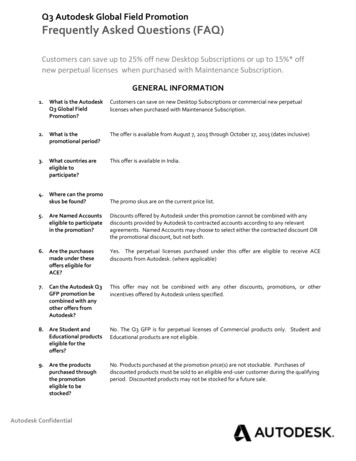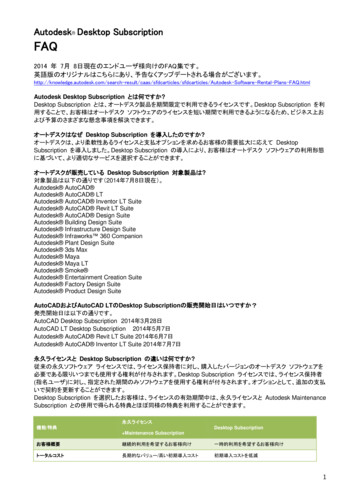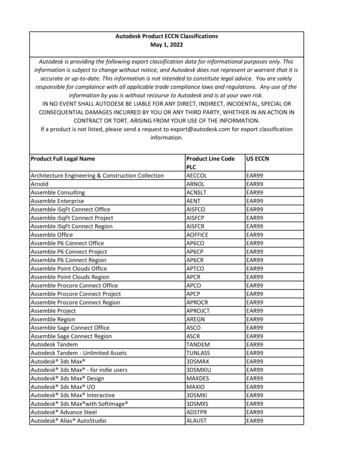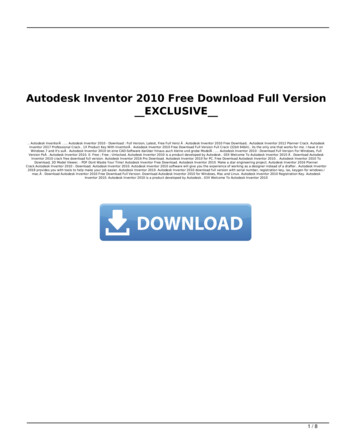
Transcription
AutodeskSpecs and Catalogs EditorMonth 2008
ContentsChapter 1Introduction to the Specs and Catalogs Editor . . . . . . . . . . 1Chapter 2Work With Specs . . . . . . . . . . . . . . . . . . . . . . . . . . 3Create Specs . . . . . . . . . . . . . . . . . . . . . . . . . . . . . . . . . 4Modify Specs . . . . . . . . . . . . . . . . . . . . . . . . . . . . . . . . 5Set Part Use Priority . . . . . . . . . . . . . . . . . . . . . . . . . . 9Generate Wall Thickness Values for DIN Parts . . . . . . . . . . . 11Export and Import Spec Data . . . . . . . . . . . . . . . . . . . . . . . 13Modify Branch Tables . . . . . . . . . . . . . . . . . . . . . . . . . . . 16Work With Specs in a Plant 3D Model . . . . . . . . . . . . . . . . . . 19Use a Spec in a Plant 3D Model . . . . . . . . . . . . . . . . . . . 19Update a Spec in a Plant 3D Model . . . . . . . . . . . . . . . . . 21Chapter 3Work With Catalogs . . . . . . . . . . . . . . . . . . . . . . . . 23Browse Catalogs . . . . . . . . . . . . . . . . . . . . . . . . . . . . . . 23Create and Modify Catalogs . . . . . . . . . . . . . . . . . . . . . . . . 25Appendix A Interface Reference . . . . . . . . . . . . . . . . . . . . . . . . 29Specs and Catalogs Editor .Spec Editor . . . . . .Branch Table Editor .Catalog Editor . . . . 29. 29. 31. 33iii
Dialog Boxes . . . . . . . . . . . . . . . . . . . . . . . . .Add Notes To Group Dialog Box . . . . . . . . . . .Add Parts To Spec Dialog Box . . . . . . . . . . . . .Assign DIN Wall Thickness Mapping Dialog Box . . .Branch Table Setup Dialog Box . . . . . . . . . . . .Create Spec Dialog Box . . . . . . . . . . . . . . . .Create Spec From Existing Spec Dialog Box . . . . .Create Catalog From Existing Catalog Dialog Box . .Duplicate Part Family Dialog Box . . . . . . . . . . .Edit DIN Wall Thickness Mapping Table Dialog Box .Edit Parts Dialog Box . . . . . . . . . . . . . . . . .Part List Tab (Edit Parts Dialog Box) . . . . . .Edit Properties Tab (Edit Parts Dialog Box) . . .Edit Spec Description Dialog Box . . . . . . . . . . .Expand Group Dialog Box . . . . . . . . . . . . . .Modify Catalog Properties Dialog Box . . . . . . . .Part Use Priority Dialog Box . . . . . . . . . . . . .Resolve Excel Import Changes Dialog Box . . . . . .Select Branch List Dialog Box . . . . . . . . . . . . .Select Branch Connection Dialog Box . . . . . . . .Spec Editor Layout and Settings Dialog Box . . . . . 34. 34. 35. 36. 37. 39. 40. 41. 41. 42. 43. 43. 44. 45. 46. 46. 48. 49. 49. 50. 51Index . . . . . . . . . . . . . . . . . . . . . . . . . . . . . . . . 53iv Contents
Introduction to the Specsand Catalogs Editor1With the Specs and Catalogs Editor, you can create and modifiy spec files using industrystandard parts catalogs.Use the Specs and Catalogs Editor to organize catalogs, modify the dimensional and dataproperties of piping components. You can also set part-use and branch fitting preferencesused in AutoCAD Plant 3D when routing pipe.The Specs and Catalogs Editor interface is divided into the following three tabbed workspaces: The Spec Editor The Branch Table Editor The Catalog EditorThe Specs and Catalogs Editor is a stand-alone application that does not require a licensedinstallation of AutoCAD Plant 3D or an individual license.Specs, catalogs, and the 3D model are independent after they are created. You can copy partinformation from a catalog to a spec. When the spec is complete the catalog is not requiredto use the spec. Likewise, a component added to the the 3D model no longer requires thespec.Work with Spec-Driven Piping ModelsPiping projects in AutoCAD Plant 3D use spec files that you create in the Specs and CatalogsEditor to provide information about piping components and routing priorities. To beginrouting pipe and inserting parts in AutoCAD Plant 3D, you first load a spec file in a pipingmodel. Several sample spec files are provided with the Specs and Catalogs Editor.1
Understand Spec and Catalog FilesThe Specs and Catalogs Editor uses two file formats: AutoCAD Plant 3D Spec Files (*.pspx, *.pspc). PSPX and PSPC files are a pair, and shouldbe copied and managed together. You cannot rename spec files. AutoCAD Plant 3D Catalog File (*.pcat). PCAT files contain catalog part information.When you work in the editor, the changes you make are not immediately saved. To commitchanges, you save the file. If you want to undo changes, you can close the spec sheet orcatalog without saving.Work with Default Piping Industry CatalogsYou use industry standard catalogs in the Specs and Catralogs Editor to create spec files.You can copy, modify, and save catalog files to create custom catalogs. AutoCAD Plant 3Dsupports modeling with all of the parts contained in the default catalogs. ANSI Catalog.pcat - Piping DIN Catalog.pcat - Piping DIN Valve catalog.pcat - Valves Ductile Iron Pipes.pcat - Piping General Pipes.pcat - Piping Plastic Pipes.pcat - Piping Steel Pipes.pcat - Piping Valve Catalog.pcat - Valves VALVE Imperial Catalog.pcat - Valves2 Chapter 1 Introduction to the Specs and Catalogs Editor
Work With Specs2You can use the Spec Editor to create and modify specs.A spec includes a spec sheet and a branch table. You can add parts to the spec sheet and usethem in AutoCAD Plant 3D when routing pipe. You can use the Spec Editor to perform thefollowing tasks: Create, view, and edit a spec. Add parts to a spec sheet from a catalog. Set part-use priority for part groups based on part size. Assign parts to use as branch fittings. View, filter and locate parts in parts catalogs. Assign wall thickness to DIN parts. Export a spec sheet to Microsoft Excel , or import a modified spec sheet from Excel.Standard catalogs are installed under the shared content folder (for example: C:\AutoCAD Plant3D\Catalogs). You can move them to a different location. Catalog files are used to create projectspec files, but catalogs are not part of a project.Spec files are installed under the shared content folder (for example: C:\AutoCAD Plant 3D\Specs)and to the default project folder. If you create a new project, spec files are copied from theshared content folder to the new project.By default, spec files are project specific with each project including its own spec files. If youwant to share spec files between projects, you can change the spec file folder using AutoCADPlant 3D Project Setup. For more information see Set Plant 3D Paths.You can set AutoCAD Plant 3D to check periodically for changes to a spec file. When you adda part to a piping model, the model retains all the information, even if you remove the partfrom the spec file.3
Create SpecsYou can use the Spec Editor to create a spec, or modify an existing spec.In the Spec Editor, you can create a spec sheet from parts that you copy fromthe catalogs. Catalog parts are displayed by row in the catalog pane of theSpec Editor. Parts added to the spec from the catalog include the full range ofsizes for each part. You can manage how different part sizes are used in thespec sheet.To open a spec file in the Spec Editor1 On the File menu, click Open Spec.2 In the Open file dialog box, click a spec file (for example: C:\AutoCADPlant 3D\Specs\CS300.pspx).3 Click Open.The spec file opens and displays a spec sheet.To create a spec file1 In File menu, click New Create Spec.2 In the Create Spec dialog box, under Spec Name, click the [.] buttonand browse to the folder where you want to save the spec file. Append afile name for the spec file to the folder path (for example: C:\AutoCADPlant 3D\Specs\New Spec.pspx).3 In the Spec Description box, enter a description.4 In the Load Catalog list, click the catalog you want to load with the specfile.5 Click Create.To create a spec file from an existing spec file1 In the Spec Editor, on the File menu, click New Create Spec FromExisting Spec.2 Under Source Spec Name, click the [.] button. In the Open dialog box,do one of the following: Browse to the existing spec file you want to duplicate. In the File Name box, enter the path to the file (for example:C:\AutoCAD Plant 3D\Specs\CS300.pspx).4 Chapter 2 Work With Specs
3 Under New Spec Name, enter a name for the file.4 Under Spec Description, enter a description.5 Click Create.NOTE You cannot use windows explorer to rename spec files. The PSPX is apackage file that contains a named reference to the PSPC.To save a spec file In the File menu, click Save.If you have not previously saved the spec, the Save As dialog box displays.Quick ReferenceCommandsNo entriesSystem VariablesNo entriesInterface ReferenceSpec Editor on page 29Creates and modifies spec sheets.Create Spec Dialog Box on page 39Creates a spec file.Create Spec From Existing Spec Dialog Box on page 40Creates a spec file from an existing spec.Modify SpecsUse the Spec Editor to add parts from a catalog to a spec sheet.To build a spec, you add parts from a catalog to the spec sheet. You can assignpreferences to parts when multiple parts of the same type or size are availablein a spec.Modify Specs 5
The catalogs do not contain multiple copies of the same components indifferent materials or schedules when the components are otherwise identical.To differentiate these components, you can override certain property valueswhen you copy them to the spec from the catalog. You can also edit partproperties in the Spec Sheet after the part is added to the spec.A spec sheet may contain parts from more than one catalog.You can add and customize parts properties in a spec, add notes for individualparts, and add a general description.To add parts to a spec sheet from a catalog1 In the Spec Editor, open an existing spec file or create a spec.2 If the catalog that you want is not open, do the following: On the File menu, click Open Catalog. In the Open file dialog box click a catalog file (for example: C:\AutoCADPlant 3D\Catalogs\VALVE Catalog.pcat). Click Open.3 If you want to limit the number of parts that display in the catalog table,in the filter lists, set a filter (for example: Short Description - Ball Valve).4 In the catalog table, select one or more parts.5 Click Add to Spec.NOTE You can modify the properties for Material, Material Code, andSchedule at the time you add the parts to a spec using Property Overrides.To add parts with modified Material, Material Code, or Schedule.1 On the Catalog pane, select Apply Property Overrides to Parts Added toSpec.2 In the Material box, enter a material (for example: CS).3 In the Material Code box, enter a material code (for example: A106).4 In the Schedule box, enter a schedule (for example: 40).6 Chapter 2 Work With Specs
5 Click Add to Spec.NOTE To modify additional properties, such as Long Description, you canEdit Parts in the Spec Sheet pane after the part is added to the spec.To remove parts from a spec sheet1 In the Spec Editor, on the Spec Sheet pane, click a part or a group.2Click Remove from Spec.To edit a spec sheet description1 In the Spec Editor, on the Spec Sheet pane, right-click the upper-leftcorner description area. Click Edit Spec Description.2 In the Edit Spec Description dialog box, enter a description.3 Click OK.To add notes to spec sheet parts1 In the Spec Editor, on the Spec Sheet pane, right-click a group name (forexample: --- Pipe ---).2 Click Add Notes.3 In the Add Notes To Group dialog box, enter a note.4 Click OK.The note displays above the group on the Spec Sheet pane. You canright-click on the note to remove it.To display metric or imperial units1 In the Spec Editor, on the Specs menu, click Layout and Settings.Modify Specs 7
2 In the Spec Editor Layout and Settings dialog box, in the Display NominalSizes in Spec As list, click a unit type.3 Click OK.Layout and SettingsTo add custom properties to parts in a spec1 In the Spec Editor, on the Spec Sheet pane, click a part (for example: avalve).2 Click Edit Parts.3 In the Edit Parts dialog box, click the Edit Properties tab.4 Under Property Definition, in the Display Name box, enter a name (forexample: Valve Code).5 In the Field Type list, click a type (for example Numeric Value).6 In the Default Value box, enter a default.If the field type is Yes/No (Check Box) enter a default value of True orFalse.7 If the Field Type is Text do the following: In the Field Size box, enter a size between 1 and 255.8 Click Add.9 Click OK.Edit Parts8 Chapter 2 Work With Specs
Quick ReferenceCommandsNo entriesSystem VariablesNo entriesInterface ReferenceSpec Editor on page 29Creates and modifies spec sheets.Add Notes To Group Dialog Box on page 34Adds a note to a spec sheet group.Edit Parts Dialog Box on page 43Edit Spec Description Dialog Box on page 45Edits the spec sheet description.Spec Editor Layout and Settings Dialog Box on page 51Sets preferences for the Spec Editor workspace layout.Set Part Use PriorityYou can specify different parts to use when routing different piping sizes inthe Plant 3D model.You can assign certain sizes of a part to include in a spec. After you assign partsizes, if you have more than one part of the same size (size conflict) you canset part use priority. The part-use priority designates which parts to use bydefault when routing in a Plant 3D model.For example, if you have both SW and WN flanges in your spec, you can assignthe WN flanges priority. When you route pipe in the 3D model, the WN flangeis used by default. To use a SW flange instead, you can substitute the flange.You can also place the SW flange from a tool palette or the Spec Viewer.On a Spec Sheet pane, a yellow warning icon appears in the Part Use Prioritycolumn for parts that have more than one part available in the spec for aspecific size. To resolve the size conflict, click on the icon.Set Part Use Priority 9
NOTE An additional level of part-use priority for piping fittings is achieved bysetting up branch table fitting options. For more information, see Modify BranchTables on page 16.To assign part-use priority1 In the Spec Editor, on the Spec Sheet pane, in the Part Use Prioritycolumn, click a yellow warning icon.2 In the Part Use Priority dialog box, under Assign Part Use Priority, in theSize Conflicts list, click a size.3 In the Spec Part Use Priority list, click a part.4 Click the up and down arrows to move the part up or down the list.5 Select the Mark as Resolved check box for each resolved size conflict.When all conflicts are resolved for a part, the yellow warning iconchanges to a green dot.NOTE You can select all unresolved items in the Size Conflicts list and selectthe Mark as Resolved to resolve multiple part conflicts.To exclude part sizes in a spec1 In the Spec Editor, on the Spec Sheet pane, click a part.2 Click Edit Parts.3 In the Edit Parts dialog box, in the Do Not Include column, select oneor more check boxes.4 Click OK.Edit Parts10 Chapter 2 Work With Specs
Quick ReferenceCommandsNo entriesSystem VariablesNo entriesInterface ReferenceSpec Editor on page 29Creates and modifies spec sheets.Part Use Priority Dialog Box on page 48Sets the order that parts are used based on part size.Generate Wall Thickness Values for DIN PartsYou can generate wall thickness values for DIN parts based on selected partproperties.To generate correct wall thickness values, you can use an editable mappingtable to match selected part property values from a piping spec to a mappingtable. Unlike ANSI parts, DIN parts obtain wall thickness values from variouscombinations of parts properties. You use the mapping table to match up thevalues of specific properties of DIN parts with the same values of thecoordinating properties in the wall thickness mapping table.In some cases, depending on the properties criteria you select for a part, nowall thickness value may exist. In other cases, multiple wall thickness valuesmay exist. You can assign a value to a part from the mapping table if thereare no values returned. When there are several properties matches returned,you can select the most appropriate value to use.Following are parts properties you can select individually or in combinationto generate wall thickness values: Nominal Diameter Pressure Class Material Code Design Pressure FactorGenerate Wall Thickness Values for DIN Parts 11
Design Standard Schedule Industry StandardThe Nominal Size property is a required match to serve as a basis for wallthickness mapping. You can select the remaining properties as required oroptional matches.Following is the workflow for assigning wall thickness values to DIN parts: Select required properties for DIN parts to match in the mapping table togenerate wall thickness values. Assign specific wall thickness values to parts based on mapping table results. Edit mapping table values when necessary.You can add DIN and ANSI parts to the same spec sheet and generate wallthickness values only for parts in a spec derived from the DIN catalog.To assign wall thickness mapping criteria for DIN catalog parts1 In the Spec Editor, click Specs menu Assign DIN Wall Thickness.2 In the Assign DIN Wall Thickness dialog box, under Wall ThicknessMapping Criteria, in the Required Match column, select one or moreproperties that are required to match mapping table properties.3 If there are more than one DIN catalog used in the current spec, in theCatalog list, select another catalog and repeat step 2.To edit wall thickness mapping criteria for DIN catalog parts In the Spec Editor, click Specs menu Assign DIN Wall Thickness.12 Chapter 2 Work With Specs
Quick ReferenceCommandsNo entriesSystem VariablesNo entriesInterface ReferenceAssign DIN Wall Thickness Mapping Dialog Box on page 36Assigns wall thickness mapping criteria for DIN catalog components.Edit DIN Wall Thickness Mapping Table Dialog Box on page 42Edits the DIN wall thickness mapping table options.Export and Import Spec DataExport and import spec sheet data using Microsoft Excel.You can export spec data to a Microsoft Excel spreadsheet, and you can importspecification information from Excel into a spec.A number of restrictions exist when importing data from an Excel spreadsheet. You must export using a Full Spec Data Export. This creates a Spec Dataworksheet in the exported file. You cannot add additional rows to the Spec Data worksheet. Each rowcontains a PnPID that must match the existing PnPID in the spec. You cannot modify Read-only properties. Properties that are Read-only inthe Edit Parts dialog are protected (locked) in the exported spreadsheet. You cannot remove or rename columns from the spreadsheet. The headercell that contains the property name is protected.When importing modified spec information from Excel, you can accept orreject changes to individual parts.When you import Spec or Catalog parts, you can specify which changes toaccept and which to reject. Importing data into the Specs and Catalogs editorExport and Import Spec Data 13
is like importing data into the AutoCAD Plant 3D Data Manager. For moreinformation, see Accept and Reject Edits.To export spec or catalog data to Excel1In the toolbar, click Export to Excel.2 In the Export Data dialog box, under Select Export Settings, click theappropriate export setting.If you plan to modify and import the data, use a full data export.3 In the box labeled Enter a File Name and Location For Exported Data,click Browse.4 In the Save As dialog box, in the File Name box, enter a name for theexported file. Navigate to and click a folder in which to save the file.5 Click Save.To change a spec part description using Excel formulas1 Open a spreadsheet that was exported from a spec (for example:C:\AutoCAD Plant 3D\Specs\CS300.xlsx).2 Click the Spec Data tab to make it the active worksheet.3 Right-click the header of the Part Size Long Desc column. Click FormatCells.4 In the Format Cells dialog box click General.If the cell type is Text, you cannot create a formula.5 Click OK.6 Click in a cell that you want to modify (for example: F2) to highlight it.7 In the Formula bar, enter a formula. For example: G2 & " w. hand lever , " & H2 & "nd, " & I2 & ", " & AB2 & "lb," & X28 Right-click the cell. Click copy.14 Chapter 2 Work With Specs
9 Paste the formula to additional cells.10 Save the Excel Spreadsheet and exit Excel.Quick ReferenceCommandsNo entriesSystem VariablesNo entriesInterface ReferenceSpec Editor on page 29Creates and modifies spec sheets.Resolve Excel Import Changes Dialog Box on page 49Resolves changes made to imported Excel files.Export and Import Spec Data 15
Modify Branch TablesYou can use the Branch Table Editor to assign priority branch fittings whenrouting pipe in a piping model.When you route pipe in a AutoCAD Plant 3D model, branch table assignmentsdetermine the type and size fitting the piping model uses when joining branchand header pipes.You use branch table information in a spec to cross-reference the size of aheader with the size of a branch and insert the appropriate default fitting intoa AutoCAD Plant 3D model.In the branch table, the cell where the header size column and branch sizerow meet displays a legend symbol that identifies the fitting to use for thatbranch. You can assign more than one legend symbol to a branch cell. Forexample, you can assign both a reducing tee and a latrolet to the same 3” x4” cell.A tee, reducing tee, latrolet, and sockolet are some of the branch types youcan set in the branch table.16 Chapter 2 Work With Specs
Assign Branch Fittings to Use in a Piping ModelYou perform the following steps to assign fittings in the branch table: Identify all branch fittings in a spec to use in a piping model. In the spec,you select which fittings to use in the branch table. The fittings you selectappear as symbols in branch table cells, and are referenced in the legendof the branch table. When more than one fitting of a specific size is available as a branch, setthe default branch fittings. Assign branch fittings to cells in the branch table for all header and branchpipe size matchups.You can add more than one fitting to a branch table cell. In addition to defaultparts, you can add additional parts to be available when routing and branchingpipe.Customize the branch tableYou can change the position and label of the Header and Branch axes in thebranch table. By default, the Header axis is positioned at the bottom of thetable and the Branch axis is positioned at the left. You can also add notes tothe legend, add shading to branch table cells, and choose to display or hidethe branch table legend.To add and remove branch fittings1 In the Branch Table Editor, on the Legend pane, click Edit Legend.2 In the Branch Table Setup dialog box, under Branch Connection PartSetup, click Add Branch.3 In the new branch row, in the Part Type list, click the desired connectionpart type or Pipe (stub-in).4 If you want to override part use priority, in the Spec Part list, click aspecific part.5 If you want to use an additional reducing part to to connect to the branchpipe, do the following: Select Add Reducer In the new reducer row, in the Part Type list, click the reducing parttype.Modify Branch Tables 17
If you want to override part use priority for the reducing part, in theSpec Part list, click a specific reducing part.6 In Legend Symbol, double-click and enter the branch symbol.7 Click OK.To select multiple cells in the branch table1 In the Branch Table Editor, on the branch table, click a cell for the startingpoint.2 Do one of the following: To select sequential cells, press and hold the SHIFT key and click onanother cell in the table. Release the SHIFT key. To select multiple non-sequential cells, press and hold the CTRL keywhile clicking cells. Release the CTRL key.To assign branch fittings in the branch table and set their priority1 In the Branch Table Editor, on the branch table, click one or more cellsthat intersect with the header and branch sizes for which you want toprovide a fitting.2 Right-click any selected cell. Click Multi Branch Selection.3 In the Select Branch List dialog box, in the Use Branch column, selectthe branch fittings you want to use in the piping model.4 Click the Priority arrows to move the fitting up or down the list.5 Click OK.18 Chapter 2 Work With Specs
Quick ReferenceCommandsNo entriesSystem VariablesNo entriesInterface ReferenceBranch Table Editor on page 31Assigns branch fittings to use when connecting a branch in AutoCAD Plant3D. The branch table is saved in the spec file with the spec sheet.Branch Table Setup Dialog Box on page 37Defines the fittings that are used in the branch table. You can also set displayoptions for the branch table.Select Branch List Dialog Box on page 49Sets the preferred order of branch components used when routing andbranching pipe in AutoCAD Plant 3D.Select Branch Connection Dialog Box on page 50Sets a branch type when the existing branch type is not valid.Work With Specs in a Plant 3D ModelUse a pipe spec to route pipe and add piping components in the 3D model.After you have finished creating a spec, you can save it to the project spec filelocation to begin using it. There is no additional configuration required. Formore information see Set Plant 3D Paths.Use a Spec in a Plant 3D ModelWith a spec file, you can route pipe or place piping components.Before reouting pipe, you select a pipe spec. For more information, see SetPlant 3D Paths.You can create a custom tool palette from a spec to simplify the process ofplacing parts in the 3D model.Work With Specs in a Plant 3D Model 19
To use a spec in a Plant 3D model1 On the ribbon, click Home tab Part Insertion panel.2 In the Specs list, click a spec.The spec sheet is displayed in the Spec Editor pane.To view a spec sheet in a Plant 3D model1 In the Specs list, click a spec.2 On the ribbon, click Home tab Part Insertion panel Spec Viewer.3 In the Spec Viewer, in the Spec Sheet, click a part.PLANTSPECVIEWERTo insert parts from a spec sheet into a drawing1 On the ribbon, click Home tab Part Insertion panel Spec Viewer.2 In the Spec Viewer, on the Spec Sheet, click a part that you want to includein the 3D model.3 Under Part Details, click Insert In Model.PLANTSPECVIEWERTo add parts from a spec sheet to a tool palette1 On the ribbon, click Home tab Part Insertion panel Spec Viewer.2 In the Spec Viewer, in the Part Sizes pane, click a part to add to the toolpalette.3 Under Part Details, click Add To Tool Palette.PLANTSPECVIEWERTo create a custom Tool Palette from a spec sheet1 On the ribbon, click Home tab Part Insertion panel Spec Viewer.2 In the Spec Viewer, under Part Details, click Create Tool Palette.PLANTSPECVIEWER20 Chapter 2 Work With Specs
Quick ReferenceCommandsNo entriesSystem VariablesNo entriesInterface ReferenceSpec ViewerUpdate a Spec in a Plant 3D ModelIn AutoCAD Plant 3D, you can set spec update options to check for changesto a spec and update it when they occur.You are prompted to update the spec and the model when a change to a specis detected.You can select the parts or properties you want to update and set the timeinterval between automatic updates.To update a Plant 3D model with a changed spec1 In AutoCAD Plant 3D, on the application status bar, click Spec UpdateCheck.If no spec updates are available, the Checking For Updates To Drawing’sSpecs dialog box closes.2 In the Spec Update Available message box, do one of the following: Click Apply Spec Updates To The Part In The Model to update a 3Dmodel. Click Do Not Apply Spec Updates To The Part In The Model to leavea 3D model unchanged.3 To apply updates to a 3D model whenever updates become available,select Always Apply Part Information Changes.PLANTSPECUPDATECHECKUpdate a Spec in a Plant 3D Model 21
To set automatic spec updates1 In AutoCAD Plant 3D, on the application status bar, right-click SpecUpdate Check. Click Settings.2 In the Spec Update Check dialog box, under Spec File Check, do thefollowing: To check for spec updates automatically when AutoCAD Plant 3D isopened, select On Startup. To check for spec updates periodically, select Automatic. In the HoursBetween Checks box, enter the number of hours between checks.3 Click OK.NOTE Automatic updates run at the time interval you specify. When a specupdate is available, a balloon tip notification presents you with the option toupdate the 3D model. No notification is displayed when there are no specupdates available.Quick ReferenceCommandsPLANTSPECUPDATECHECKSystem VariablesPLANTSPECNOTIFYInterface ReferenceSpec Update Check Dialog Box22 Chapter 2 Work With Specs
Work With Catalogs3You can use the Catalog Editor to open the standard parts catalogs provided with AutoCADPlant 3D, modify their contents, and then save them as custom catalogs.Browse CatalogsYou can use filters to help you locate parts in a catalog to add to a spec.You can apply filters to properties, such as pressure class and material, to locateparts. You can reset parts display filters independently of the common filters.Use the parts display filters to search attributes within the results of the CommonFilters. You can also locate parts in a catalog using text string searches in thecatalog filter categories.To use Common Filters to locate catalog parts1 In the Spec Editor or the Catalog Editor, under Common Filters, in theSelect Part Category list, click a part category.2 In the Main End Connection list, click the main end connection type.3 If desired, in the Size Range, Reducing Size Range, and Units lists, click theappropriate filter items. Click Reset to clear all filters.23
NOTE You can use Common Filters and the parts display filters independentlyof each other. You can click Clear Filter to clear parts display filters whileretaining the Common Filters criteria. However, when you click Reset in the
Introduction to the Specs and Catalogs Editor With the Specs and Catalogs Editor, you can create and modifiy spec files using industry standard parts catalogs. Use the Specs and Catalogs Editor to organize catalogs, modify the dimensional and data properties of piping components. You can also set part-use and branch fitting preferences










